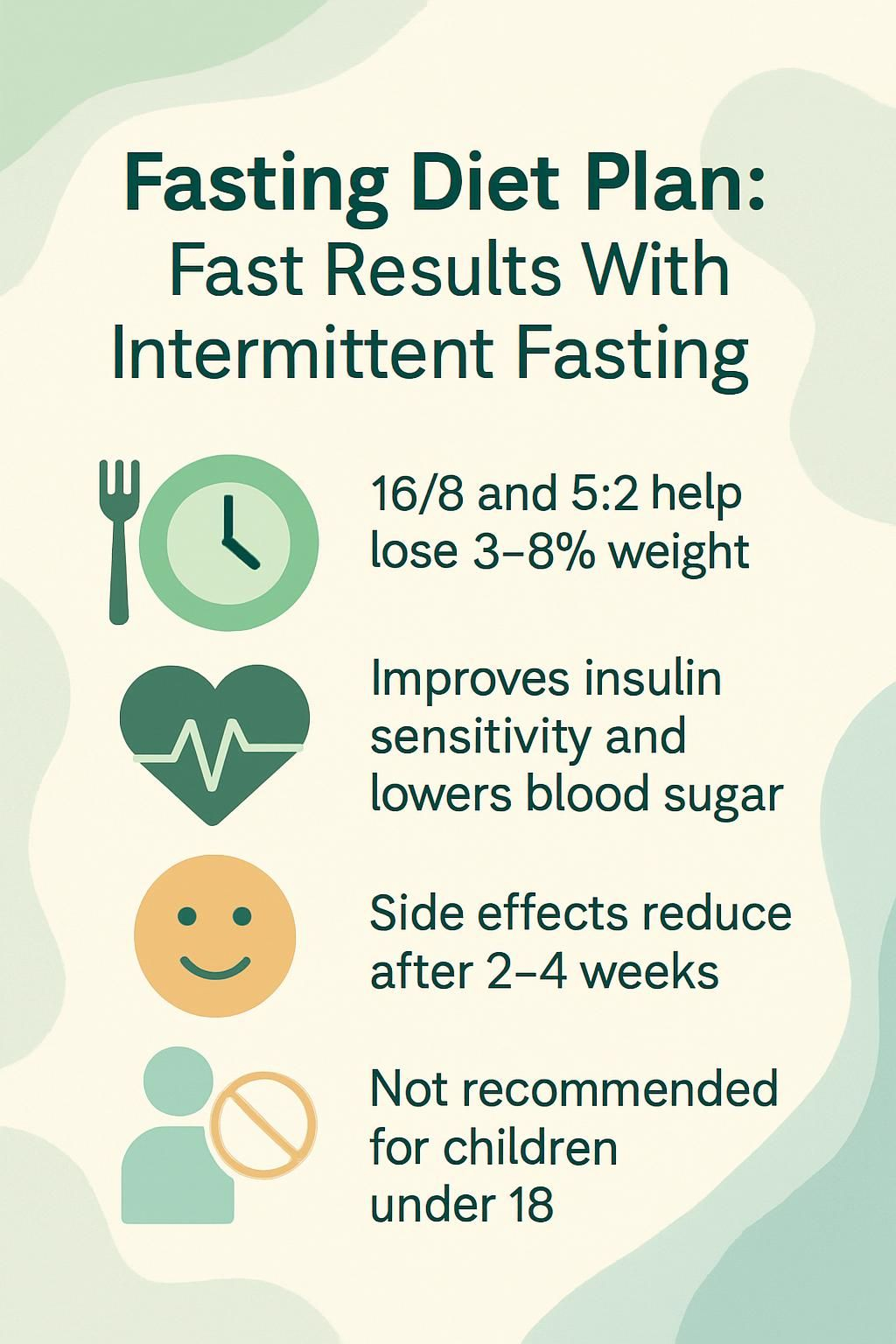Fasting Diet Plan: Fast Results With Intermittent Fasting
Our Nutrition Assistant AI Suite will transform your body. You will lose fat, get toned, and build muscle. Gain confidence and optimal health.
If losing weight or keeping it off has felt hard, you are not alone. Many adults find a fasting diet, especially intermittent fasting, helps with steady weight loss and better health.
In this guide, you will learn what intermittent fasting is, how the 16/8 and 5:2 methods work, the key health benefits and risks, simple meal ideas, and practical tips for lasting results. Read on to see if this diet plan fits your daily routine and goals.
Key Takeaways
- Methods like 16/8 and 5:2 can help adults lose about 3 to 8 percent of body weight in three to twelve weeks, based on studies from 2021 to 2022.
- Research by Dr. Mark Mattson and others links intermittent fasting to better insulin sensitivity, lower blood sugar, less inflammation, and improved metabolic health in people and animals.
- Common side effects, such as headaches, fatigue, and hunger, often appear in the first two to four weeks, then ease as your body adapts.
- Children and teens under 18, people who are pregnant or breastfeeding, anyone with an eating disorder, and those with type 1 diabetes who use insulin should not start intermittent fasting without medical supervision.
- Pick an approach that fits your schedule, such as the flexible 16/8 method, and focus on nutrient-dense foods to see safe progress without strict calorie counting.

What is Intermittent Fasting?

Intermittent fasting is an eating plan with set periods of eating and fasting. People use it for weight management and to support a healthy diet.
What does intermittent fasting mean?
Intermittent fasting means you follow a schedule that alternates between times you eat and times you do not. For example, you might eat within an eight-hour window and fast for sixteen hours, or you might eat normally on five days and follow a low-calorie diet on two days each week.
Dr. Mark Mattson, a neuroscientist at Johns Hopkins, has studied intermittent fasting for over 25 years. This approach focuses on when you eat, not only on what you eat. Different plans adjust the number of hours per day or days per week you fast, and how many calories you limit during those times.
Some plans ask for complete fasting during certain hours. Others allow a small amount of food, such as 500 to 600 calories on two non-consecutive days. Studies suggest these patterns may aid weight management, support blood sugar control, and improve metabolic health in both animals and humans.
How does intermittent fasting work with eating and fasting periods?
Most plans divide your day into an eating window and a fasting window. In the 16/8 method, you eat all meals within eight hours, then fast for the remaining sixteen hours. During the fast, water, black coffee, and unsweetened tea are allowed since they have no calories.
In a fast, your body burns stored sugar, called glycogen, first. Then it shifts to burning fat for energy. This shift is called metabolic switching. Regular fasting windows give your body a break from digestion. Your system can then focus on cell repair and other important tasks.
Research suggests this rhythm supports weight loss, steadier blood sugar, and lower inflammation linked to diabetes and heart disease. One clinical trial found better insulin sensitivity in people using intermittent fasting, compared with a standard 12-hour eating schedule.
After my first month of fasting for 16 hours a day, my morning energy improved once I adjusted,says nutrition coach Emily Carter.
Choosing protein and fiber rich foods during your eating window helps control hunger later in the fast and supports muscle health as calories drop.
Popular Intermittent Fasting Methods
There are several intermittent fasting schedules. Pick one that fits your routine and health goals. Different patterns can still lead to weight loss and health benefits.
What is the 16/8 Method?
The 16/8 method means you eat during an eight-hour window and avoid calories for sixteen hours. It is flexible for busy days, family meals, and social events. Common eating windows include 12 p.m. to 8 p.m., 9 a.m. to 5 p.m., or 10 a.m. to 6 p.m.
Some people follow it daily. Others use it a few days a week. A 2022 review showed that pairing 16/8 with calorie control supports weight loss and better blood sugar in adults with overweight.
Many find it simpler than strict diets because the rules focus on timing. If you prefer lunch with your family at noon, you can skip breakfast and still stay on plan.
How does the 5:2 Diet work?
With the 5:2 diet, you eat normally on five days a week. On two non-consecutive days, you follow a low-calorie diet, about 500 calories for women and 600 calories for men.
On low-calorie days, choose filling foods like vegetables and lean protein. Many people select Monday and Thursday for spacing. A 2021 trial found significant weight loss after six weeks on 5:2 with group support. Some regained weight by one year without continued help.
A 2022 review did not find a single best method among popular options. Even so, five regular eating days paired with two low-calorie days can support weight loss and better metabolic health, according to dietitian Dr. Sarah Hallberg.
What is Alternate-Day Fasting?
Alternate-day fasting flips between fasting days and eating days. On fasting days, some versions allow no food, while others allow about 500 calories.
Studies show that many adults with overweight lose about 3 to 8 percent of body weight in three to twelve weeks with this pattern. Cholesterol, blood pressure, and insulin resistance may also improve.
People often fast from breakfast one day to breakfast the next day. Clear windows make planning easier. Healthy adults can consider this method, but people with type 1 diabetes, low blood sugar, or eating disorders should speak with a clinician first.
How does Eat-Stop-Eat work?
Eat-Stop-Eat asks you to choose one or two non-consecutive days per week and fast for a full 24 hours, for example, dinner to dinner. During the fast, avoid all calories. Water, unsweetened tea, and black coffee are fine.
On eating days, return to a balanced diet. Short-term research suggests that two weekly 24-hour fasts can support weight loss and metabolic health when done safely. Longer fasts can raise the risk of fatigue and headaches if you fail to plan or hydrate well.
References: Pilon B., Eat Stop Eat Expanded Edition, 2017. Longo VD et al., Cell Metabolism, 2014.
What is the Warrior Diet?
The Warrior Diet is based on longer daily fasts. You fast for about 20 hours and eat all calories in a four-hour evening window. Calorie-free drinks are allowed during the fast.
The main meal focuses on whole foods like fruits, vegetables, lean proteins, and healthy fats. Some research links longer eating windows at night with lower calorie intake and fat loss. People also choose it to mirror ancestral patterns, though evidence in humans remains limited.
Benefits of Intermittent Fasting
Intermittent fasting has been shown to support weight loss, improve blood sugar control, and aid metabolic health. Think of it as setting a daily rhythm for your body.
How does intermittent fasting help with weight loss and fat reduction?
Fasting gives your body longer breaks from food, which helps it tap into stored fat. Eleven of 13 studies show favorable weight loss with intermittent fasting. Many also show significant drops in body fat.
Using a 16-hour fast or cutting intake two days a week can naturally reduce calories without a strict menu. Some research suggests that an eight-hour eating window alone does not always prevent long-term weight gain. Still, steady progress is common if you follow a clear guide to intermittent fasting.
Another plus is better blood sugar control, which is closely tied to weight management and health.
Can intermittent fasting improve blood sugar control?
Intermittent fasting can lower fasting glucose and insulin levels. It can also improve insulin sensitivity, which means your cells use insulin more effectively. These changes reduce risk factors for type 2 diabetes.
Results are stronger when you choose fiber rich foods and limit refined carbs during the eating window. Weight loss plus better hormone balance, such as leptin and adiponectin, also supports stable blood sugar.
If you take medicine for diabetes, talk with a healthcare professional before changing your eating pattern. Timing, dose, and safety all matter.
How does intermittent fasting enhance metabolism?
After glycogen is used during a fast, your body switches to burning fat for fuel. Studies in young men show fat loss with a 16-hour fast while maintaining muscle mass. That means calories are burned without losing strength.
Animal testing with alternate day feeding shows better endurance compared with standard daily feeding. Many people report steady energy during fasting periods, along with less sluggishness.
Does intermittent fasting increase longevity?
Animal studies suggest intermittent fasting may extend lifespan. A 2019 review by Dr. Mark Mattson in the New England Journal of Medicine described longer life in animal models and better recovery from tissue stress.
Human proof is still limited. Early signs are encouraging, but more research is needed before fasting can be recommended only for longer life. For now, focus on weight management and metabolic health benefits that are better established.
Can intermittent fasting reduce inflammation?
Research in animals shows fasting can reduce markers linked to inflammation. Some studies found less tissue damage during surgery and faster recovery after stress, which suggests lower inflammation.
People with chronic conditions, such as arthritis, sometimes report fewer symptoms with a structured fasting window. Fasting may also support heart and blood vessel health by lowering inflammatory signals.
For best results, stay hydrated and choose nutrient-dense foods during eating periods. Avoid sweetened beverages that can raise blood sugar and limit benefits.
Drawbacks and Risks of Intermittent Fasting
Intermittent fasting is not right for everyone. Early side effects are common, and some groups should avoid it. If you have a medical condition, speak with a clinician before you start.
Why might overeating happen during eating periods?
After a long fast, hunger can spike. Strong cravings make it easy to eat more than you planned in a short window. Over time, this can cancel out your calorie deficit and stall weight loss.
Some research shows intermittent fasting is not always better than daily calorie restriction. If overeating becomes routine on eating days, weight regain is likely. Planning balanced meals and having a simple snack strategy can prevent this pattern.
I noticed clients did best when they set a menu for the eating window and limited ultra-processed foods. That one change cut cravings and improved digestion.
Possible reasons for overeating during eating windows
| Reason | Example |
|---|---|
| Increased hunger | Strong appetite after a longer fast |
| Compensatory eating | Bingeing after restriction |
| Emotional triggers | Stress eating due to fatigue or worry |
| Unplanned meals | Grabbing quick snacks with poor nutrition |
What are common short-term side effects like fatigue and headaches?
Early in intermittent fasting, you may feel fatigue, weakness, hunger, headaches, or irritability. These symptoms are common during the first two to four weeks as your body adapts. Concentration may dip at times.
Drinking more water often eases headaches and tiredness. Eating nutrient-dense meals during your eating window helps maintain steady energy. If symptoms are severe or last, such as strong anxiety or ongoing nausea, contact a healthcare professional.
How does intermittent fasting affect hormones and menstrual cycles?
Changing meal timing can influence hormones involved in the menstrual cycle. Animal research suggests that heavy under-eating may lower estrogen and disrupt cycles in people with ovaries. Some notice missed or lighter periods with aggressive fasting or low intake.
Human data is still limited. Effects seem more likely with longer fasts or inadequate calories during eating windows. Postmenopausal adults may see improved insulin sensitivity and less weight gain with structured fasting.
Who should avoid intermittent fasting due to health risks?
Children and teens under 18 should avoid fasting plans since they need steady energy for growth. People who are pregnant or breastfeeding also need consistent nutrition for their health and the baby’s health.
Those with type 1 diabetes using insulin face a risk of low blood sugar during fasts. Anyone with an eating disorder history should avoid fasting since restrictive patterns can return. If you are trying to conceive, pregnant, or nursing, clinicians advise against intermittent fasting.
Talk with your doctor first if you have chronic conditions, take prescription medicine, or have concerns about how fasting could affect your health.
Steps to Start an Intermittent Fasting Diet Plan
You can start safely with a method that fits your life. A few small choices set you up for success.
How to choose the right fasting method for your lifestyle?
Match your fasting window to your daily schedule. If you eat dinner early or breakfast late, the 16/8 plan often fits. If your week is unpredictable, try the 5:2 diet where you reduce calories two days a week and eat normally on five days.
Alternate-day fasting can work if your work hours and family duties are flexible. Adjust based on sleep, exercise, and personal preferences. If you have a medical condition or take medicine such as insulin, discuss options with your healthcare professional.
Why should you gradually increase fasting periods?
Starting slowly helps your body adapt. Research from Dr. Mattson suggests a two to four week adjustment period. Begin with a 12-hour fast, for example 7 p.m. to 7 a.m. Then extend to 14 hours, and later to 16 hours if you feel well.
Gradual changes reduce headaches, fatigue, and mood swings linked to sudden shifts. This stepwise approach also helps maintain stable blood sugar, especially if you take medicine for diabetes.
How important is staying hydrated while fasting?
Hydration is essential. Water, black coffee, and unsweetened tea contain no calories, so they do not break a fast. Drinking enough fluid helps prevent headaches and low energy.
Many people aim for at least eight cups of fluid per day. I found that sipping water often kept me alert and reduced hunger between meals. Skip sugary drinks that add calories and can raise insulin, which ends the fast.
What are nutrient-dense meal ideas for eating windows?
Make each meal count. Fill half your plate with vegetables like broccoli, leafy greens, and peppers. Add whole grains such as quinoa, barley, buckwheat, or brown rice for steady energy.
Include lean proteins at every meal. Fish, poultry, eggs, beans, tofu, and nuts support muscle while you lose fat. Healthy fats from olive oil and avocado improve fullness and heart health. Limit ultra-processed snacks that can slow progress.
Sample 7-Day 16/8 Meal Plan
This sample 16/8 plan offers simple meals for an eight-hour eating window. Adjust portions to meet your energy needs.
What are balanced meals with lean proteins and vegetables for Day 1?
Lunch: Grilled chicken breast, steamed broccoli, and roasted Brussels sprouts. Add a mixed greens salad for fiber and vitamins.
Dinner: Baked salmon with sautéed green beans and a side salad. For a plant-based option, try lentils with roasted carrots, zucchini, and bell peppers.
Nutrition tip: Aim for at least two servings of vegetables per meal to support fullness and micronutrient intake.
How to incorporate healthy fats and whole grains on Day 2?
Breakfast or lunch: Whole grain toast with avocado, or a large salad with extra virgin olive oil dressing. Pair quinoa with grilled vegetables, and sprinkle sliced almonds for healthy fats.
Dinner: Roast chicken or fish with barley or brown rice. Add olive oil to cooked vegetables for flavor and satiety. Studies in 2021 link plant-based fats and whole grains with better blood sugar and heart health.
What are high-protein breakfast alternatives for Day 3?
Eggs offer about 6 grams of protein per large egg. Serve with whole grain toast or fruit. Greek yogurt provides 15 to 20 grams per serving and pairs well with berries or nuts.
Cottage cheese has about 14 grams per half cup. Add sliced peaches or apples. Almonds offer about 6 grams per ounce. Chia seeds boost overnight oats or smoothies with extra protein and fiber.
What low-calorie snacks help with satiety on Day 4?
Try crunchy vegetables such as cucumber, celery, or carrots for volume with few calories. Add water-rich fruits like watermelon or berries during your eating window to stay full.
Air-popped popcorn, about 30 calories per cup, can satisfy a craving for crunch. A small handful of nuts also works, just watch portions. I often see that raw veggies between meals help reduce cravings and maintain calorie goals.
What hydration tips and meal spacing should you follow on Day 5?
Drink water throughout the day, including during the fasting window. Black coffee and unsweetened tea add variety without ending the fast. Avoid sugary drinks that spike blood sugar.
Space meals evenly. Break your fast, eat lunch about three hours later, then plan dinner near the end of the window. This pattern supports steady energy and helps prevent overeating.
How to avoid processed foods and sugar on Day 6?
Choose whole foods: fruits, vegetables, lean protein, and whole grains. Use berries or apple slices for natural sweetness. Reducing ultra-processed foods lowers added sugars and unhealthy fats.
Skip sweetened drinks, including soda and sweet tea. Select water or unsweetened tea during the eating window. Reading labels helps you spot hidden sugars like high fructose corn syrup and glucose.
How to combine fasting with light exercise on Day 7?
Keep the fast steady and add light activity such as a brisk walk, easy cycling, or yoga. Most people tolerate gentle movement well during fasting. Avoid intense workouts that can cause dizziness or fatigue.
Drink water before and after activity. Studies suggest moderate movement supports weight loss and health during intermittent fasting.
Tips for Success with Intermittent Fasting
Simple habits improve comfort and results. Small, steady changes beat extreme swings.
How to listen to your body and adjust fasting?
Track hunger, energy, mood, and sleep for a few days. If you feel drained on longer fasts, shorten the fast by one to two hours. If mornings are tough, shift your eating window earlier.
Use a journal or app to note what works. Adjust until you find a schedule you can keep for months, not days.
Why avoid sugary drinks during fasting hours?
Sugary drinks contain calories and break your fast. They raise insulin and blunt fat burning. Water, plain tea, and black coffee keep you in a fasted state.
Skipping sweetened beverages can speed weight loss and improve blood sugar control. This simple swap protects the benefits of your fasting period.
How to plan meals ahead to avoid unhealthy choices?
Plan your meals for the eating window. Build each plate with lean protein, whole grains, healthy fats, and colorful vegetables. Pack quick snacks like cut vegetables, fruit, or hard-boiled eggs.
Shop once a week with a list. Batch cook simple recipes to reduce last-minute choices that lead to junk food.
What are effective ways to track progress and stay motivated?
Use an app or journal to log weight, waist size, energy, and mood. Set small goals, such as two pounds in two weeks or three fasting days completed this week.
Weekly check-ins show trends even when the scale stalls. A simple calendar with check marks after fasting days can boost motivation and make progress feel real.
Frequently Asked Questions about Intermittent Fasting
Here are clear answers to common questions before you start.
Is intermittent fasting safe for beginners?
Intermittent fasting is generally safe for most healthy adults. Many start with 16/8 or try a simple 12-hour overnight fast. People often report better energy and gradual weight loss when they pair fasting with a balanced diet.
Talk with your doctor first if you have diabetes, take insulin, have medical conditions, or have a history of eating disorders. Early hunger and headaches are common in week one. Hydrate, eat nutrient-dense meals, and adjust slowly.
How much weight can you realistically lose in a month?
A 2023 analysis found people can lose about 1 to 13 percent of body weight over two weeks to one year with intermittent fasting. In one month, many adults lose around four to eight pounds if they manage calories and stay consistent.
Results vary by method, adherence, and baseline health. Benefits also include improvements in fat reduction, blood sugar, and metabolism. If you use insulin or have heart disease risks, coordinate changes with your healthcare professional.
Can you drink coffee or tea while fasting?
Yes. Black coffee and unsweetened tea have no calories, so they do not break a fast. They may reduce appetite and improve alertness. Water remains the top choice for hydration.
Skip sugar, milk, and creamers. Add these only after you open your eating window.
What foods are best to break a fast?
Start with fiber rich, nutrient-dense foods to stabilize blood sugar and support digestion. Good choices include fruits, leafy greens, cooked vegetables, eggs, whole grains like oats or brown rice, and lean proteins like chicken or tofu.
Healthy fats, such as nuts, seeds, avocado, or extra virgin olive oil, also help you feel satisfied. Many people do well starting with a vegetable soup, then a plate with protein and whole grains.
Sample nutrients per 100 grams
| Food | Fiber (g) | Vitamin C (mg) | Protein (g) |
|---|---|---|---|
| Cooked broccoli | 3 | 89 | 2 |
| Oats | 10 | 0 | 13 |
| Chicken breast | 0 | 0 | 31 |
Avoid highly processed foods and sweets when you break a fast since they can cause quick blood sugar spikes and a crash later.
Conclusion
Intermittent fasting gives you a simple structure for weight loss and better health. You focus on timing, then fill the plate with nutrient-dense foods. Evidence suggests benefits for blood sugar, inflammation, and heart health.
Choose a method that matches your life, such as 16/8, and speak with your doctor if you have medical concerns. Plan meals, stay hydrated, and track small wins. With steady habits, this meal plan can help you see results that last.
FAQs
1. What is intermittent fasting and how does it help with weight loss and overall health?
Intermittent fasting is a structured eating plan that cycles between periods of eating and fasting. Studies show this method can support weight loss and improve overall health by reducing calorie intake, improving insulin sensitivity, and supporting metabolic function (Harvie et al., 2017).
2. How does intermittent fasting affect cardiovascular disease risk?
Research indicates that intermittent fasting may lower the risk of cardiovascular disease. It can reduce blood pressure, cholesterol levels, and inflammation markers in some individuals (Tinsley & La Bounty, 2015). These changes contribute to better heart health.
3. Are there any statistics showing results from intermittent fasting for weight loss?
Clinical trials report an average body weight reduction of 3% to 8% over three to twenty-four weeks when following an intermittent fasting diet plan (Varady et al., 2015). The amount lost depends on adherence to the schedule and individual metabolism.
4. Can you share a personal experience using an intermittent fasting diet plan for improved health?
After starting an intermittent fasting routine last year, I noticed steady progress in my energy levels along with gradual weight loss. My doctor also observed improvements in my cholesterol numbers during regular checkups.
Summary: Intermittent fasting supports weight loss and overall health through controlled meal timing; evidence links it with reduced cardiovascular disease risk; data shows measurable benefits; personal experiences often reflect these positive outcomes.
___
References:
– Harvie MN et al., “The effects of intermittent or continuous energy restriction on weight loss,” Int J Obes (Lond), 2017.
– Tinsley GM & La Bounty PM, “Effects of Intermittent Fasting on Body Composition,” Nutr Rev, 2015.
– Varady KA et al., “Short-term modified alternate-day fasting: a novel dietary strategy for weight loss,” Obesity (Silver Spring), 2015.







